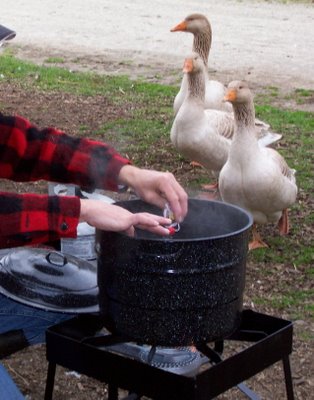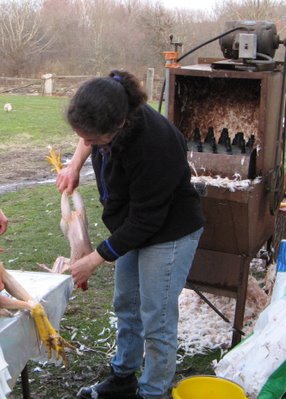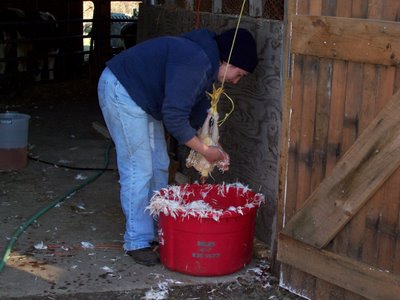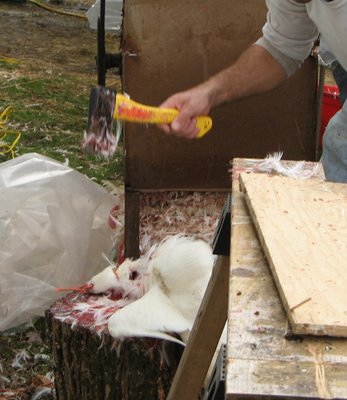Part 1 Prep Part 2 SlaughterPart 3 PluckingPart 4 Evisceration and
Chilling
Part 5 Eating & Freezing Part
6 Final Thoughts
After trying to write this post, I concluded that a movie would make a lot more sense. Maybe next year I'll try that, but for now, this is it.
Eviscerating a chicken is the process of removing the insides. It's one of those things that is much easier to show someone rather than write down the process. I'm not sure this post will be of any help in explaining how to evicerate a chicken, but I suppose the pictures show something that people don't often get to observe. Just as there is more than one way to skin a cat there is more than one way to gut a chicken. The follow is what has worked for us.
Step1. After the chicken is finished being plucked, remove the feet. These are removed at the joint. We used a knife to do this, but I think some kind of poultry or garden pruning shears would have been easier.
Step2. Slice off the oil gland. This is on the top (if the chicken is standing up) of the tail.
Step3. Cut off the neck close to the body and save it for soup. At the neck opening you will see two tubes going into the chicken. The smoother one is the esophagus which goes to the crop and the one that looks like a vacuum cleaner hose is the trachea. Loosen them from the body.
Step4. Lay the chicken on its back with the tail facing you. From just under the end of the breast bone, start to cut the skin. Cut down toward the vent about maybe halfway. You want to be careful not to knick the intestine, so you might want to pinch or hold the skin toward you as you are doing this. Now cut the skin from the bottom of the incision to each side. The incision will be an upside down T at this point and should be big enough to squeeze your hand through. If it's not then enlarge it. Do NOT cut all the way down to the vent though.
Step5. Now comes the fun part. You are going to reach inside. The first time I did this I was surprised that it was warm inside a chicken. After years handling chicken for food prep which of course comes from the fridge very cold, I was initially surprised to put my hand inside a chicken and find it warm. It shouldnÂ’t have been a surprise, but it was.
Step6. As you are squeezing your hand through the opening that you just made, run your fingers up along the breast bone. When you are all the way in, grab whatÂ’s inside and pull it out. It takes a little force, but remarkably most all of the insides come out. Do not detach the intestine from the vent just yet.
Step7. Now, cut around the vent. This will be a cut the is shaped like a U. This will separate what you just pulled out and you will have removed the vent without cutting the intestine. You are almost done now and you chicken looks like a “normal” chicken.
Step8. It is possible that when you pulled out everything from the inside the lungs stayed behind. If you do not have a ‘lung puller’ (yes, there is such a thing) then reach in with your index and middle finger and scrape out the two redish pinkish things that are on the bottom and forward.
Step9. If it is a rooster you will notice two things are the size beans on the back of the chicken inside. These are the testicles and can be removed also. IÂ’ve often seen them missed in chicken that I got from the store.
Step10. Now rinse the chicken thoroughly with water inside and out.
Step11. Now you are finished and want to get the chicken cooled down. We fill tubs cold water and ice and chill the chickens down quickly in the ice water for a while before refrigerating them
Store bought chickens usually come with their, liver, heart, and gizzard. For this batch of chickens we saved the hearts and livers and I gave the feet and gizzards away to a friend at work who took them. NOTE. When you are separating the heart and liver from the rest of the insides, you must be careful not to break the gall bladder. It's the greenish thing connected to the liver. If it breaks, bile comes out. We tossed out any liver that bile got onto and then very thoroughly washed any cutting board or knife that bile got onto if we did break the gall bladder.
Shows after the insides have been removed. The large round thing is the gizzard. The dark thing is the liver. Below the liver, is the intestine.

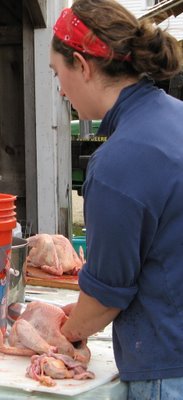
 In order to avoid some Christmas shopping I needed to do today, I decided my dog Kahlil needed exercise. So I walked him down the lane next to the cow pasture at Codman Farm. The pasture is full of "normal" cows and this one little water buffalo steer named Herman. I'd met Herman before when I had to go into the pasture for the White Rock broiler chicken project. Cows scare me a bit. They are big. Some Holsteins look as big as minivans. I once climbed into the chicken tractor because I thought a young curious bull had come too close. I wouldn't leave until someone else came into the pasture to escort me out. I knew that bull could tell I was afraid. People came and went and he never bothered them, but he made me nervous. I was kind of glad when he moved on to where ever bulls go when the get older, the auction, the freezer, I don't really know, just some place where at least he won't frighten me. Herman is different. He's not intimidating. He's very friendly. He likes people. He likes attention. I'm not at all afraid of him. He's from a breed that produces buffalo mozzarella.
In order to avoid some Christmas shopping I needed to do today, I decided my dog Kahlil needed exercise. So I walked him down the lane next to the cow pasture at Codman Farm. The pasture is full of "normal" cows and this one little water buffalo steer named Herman. I'd met Herman before when I had to go into the pasture for the White Rock broiler chicken project. Cows scare me a bit. They are big. Some Holsteins look as big as minivans. I once climbed into the chicken tractor because I thought a young curious bull had come too close. I wouldn't leave until someone else came into the pasture to escort me out. I knew that bull could tell I was afraid. People came and went and he never bothered them, but he made me nervous. I was kind of glad when he moved on to where ever bulls go when the get older, the auction, the freezer, I don't really know, just some place where at least he won't frighten me. Herman is different. He's not intimidating. He's very friendly. He likes people. He likes attention. I'm not at all afraid of him. He's from a breed that produces buffalo mozzarella.


